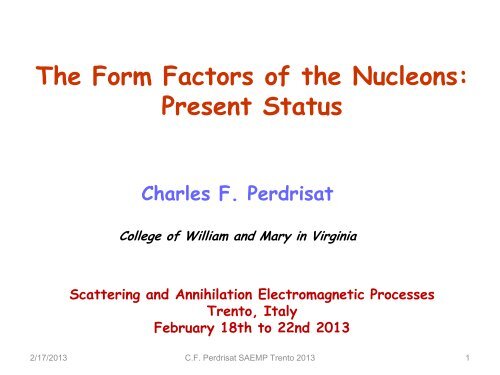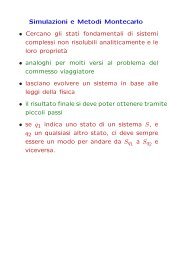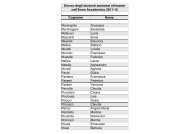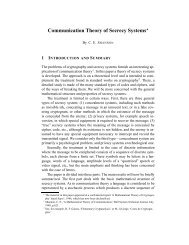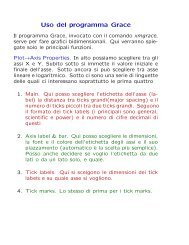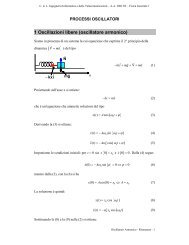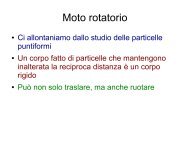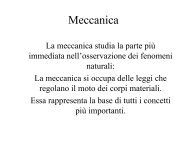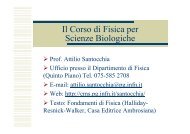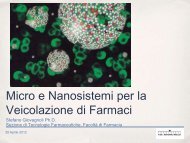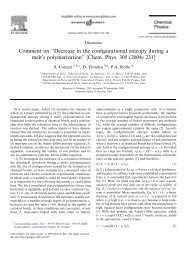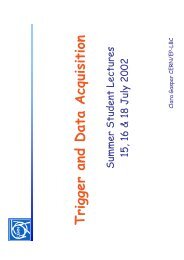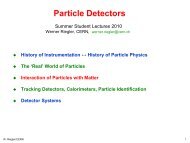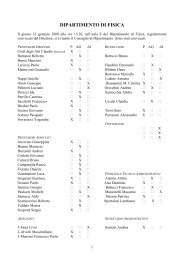The Form Factors of the Nucleons: Present Status - Fisica
The Form Factors of the Nucleons: Present Status - Fisica
The Form Factors of the Nucleons: Present Status - Fisica
Create successful ePaper yourself
Turn your PDF publications into a flip-book with our unique Google optimized e-Paper software.
<strong>The</strong> <strong>Form</strong> <strong>Factors</strong> <strong>of</strong> <strong>the</strong> <strong>Nucleons</strong>:<br />
<strong>Present</strong> <strong>Status</strong><br />
Charles F. Perdrisat<br />
College <strong>of</strong> William and Mary in Virginia<br />
Scattering and Annihilation Electromagnetic Processes<br />
Trento, Italy<br />
February 18th to 22nd 2013<br />
2/17/2013 C.F. Perdrisat SAEMP Trento 2013<br />
1
Nucleon <strong>Form</strong> <strong>Factors</strong><br />
<strong>Form</strong> factors have been obtained from<br />
elastic electron scattering cross sections<br />
from <strong>the</strong> very beginning <strong>of</strong><br />
R. H<strong>of</strong>stadter’s pioneering work at<br />
Stanford in <strong>the</strong> mid-1900s.<br />
In early 70’s <strong>the</strong> data available suggested<br />
that G Ep decreased faster than <strong>the</strong> dipole<br />
form factor G D=(1+Q 2 /0.71) -2 (see figure).<br />
<strong>The</strong> first experiment to show a strong<br />
preference for G Ep/G D ~ 1 was that<br />
<strong>of</strong> Litt et al. published in 1970, not<br />
included in this figure.<br />
Following experiments mostly confirmed<br />
<strong>the</strong> Litt results (Walker et al. 1994,<br />
Andivahis et al, 1994)) including two<br />
experiments at Jlab (Christy et al 2004,<br />
and Qattan et al. 2005).<br />
2/17/2013 C.F. Perdrisat SAEMP Trento 2013<br />
2
Results for <strong>the</strong> proton’s G Ep and G Mp form factors had reached apparent<br />
stability by 1990’s, indicating that “scaling”, i.e. <strong>the</strong> fact that G Ep/G D,<br />
G Mp/μ pG D are approximately independent <strong>of</strong> Q 2 , and ≈1, may be true.<br />
In <strong>the</strong> late 1990s it became experimentally feasible to obtain <strong>the</strong> nucleon<br />
form factors from double-polarization experiments, also based on <strong>the</strong><br />
assumption <strong>of</strong> single photon exchange, or Born approximation, as had been<br />
first suggested by Akhiezer and Rekalo in <strong>the</strong> late sixties.<br />
Spectacular experimental progress in measuring G E/G M followed <strong>the</strong><br />
opening <strong>of</strong> Jefferson Lab, for both proton and neutron. Our<br />
understanding <strong>of</strong> <strong>the</strong> shape, and charge and current distributions<br />
in <strong>the</strong> nucleon has increased considerably, and changed drastically.<br />
New information on hadron structure, such as role <strong>of</strong> quark orbital<br />
angular momentum, transverse charge density distribution, dressed<br />
quark form factor has followed in short order.<br />
2/17/2013 C.F. Perdrisat SAEMP Trento 2013 3
Outline: Nucleon <strong>Form</strong> <strong>Factors</strong><br />
<strong>The</strong> two methods to obtain GE and GM, <strong>the</strong> space-like electromagnetic<br />
form factors <strong>of</strong> <strong>the</strong> proton and neutron, are Rosenbluth separation<br />
based on cross sections, and asymmetry in double polarization as in<br />
Compare old and new results for G E and G M, proton and neutron.<br />
Highlight new paradigm.<br />
Short <strong>the</strong>ory overview.<br />
<br />
eN eN,<br />
eN<br />
eN<br />
Comparison <strong>of</strong> G E/G M and F 2/F 1 to <strong>the</strong>oretical model predictions,<br />
for proton and neutron.<br />
Some consequences for structure and shape <strong>of</strong> <strong>the</strong> nucleon.<br />
Validity <strong>of</strong> Born approximation: Radiative corrections? Or just physics.<br />
What is <strong>the</strong> radius <strong>of</strong> <strong>the</strong> proton?<br />
C.F. Perdrisat, V. Punjabi, M. Vanderhaeghen, Progress in Particle and Nuclear<br />
Physics, 59 (2007), 694, and, on <strong>the</strong> web:<br />
C.F. Perdrisat, V. Punjabi www.scholarpedia.org/article/Nucleon_<strong>Form</strong>_factors<br />
(2010)<br />
2/17/2013 C.F. Perdrisat SAEMP Trento 2013<br />
4<br />
.
One-photon exchange or Born approximation<br />
j = J = OPEX<br />
<strong>The</strong> hadronic current is:<br />
Γ<br />
μ<br />
F (q2)γ<br />
μ<br />
<br />
1<br />
iσ<br />
μν<br />
q<br />
F (q2)<br />
ν<br />
2 2M<br />
• F 1 (Dirac): electric charge and Dirac magnetic moment<br />
• F 2 (Pauli): anomalous magnetic moment<br />
<strong>The</strong> ep cross section is <strong>the</strong>n (cumbersome)<br />
2/17/2013 C.F. Perdrisat SAEMP Trento 2013<br />
5
<strong>The</strong> Sachs form factors G E (electric) and G M (magnetic) are<br />
more convenient experimentally.<br />
<strong>The</strong> two sets <strong>of</strong> form factors are connected by linear relations<br />
G E = F 1 - τF 2 , G M = F 1 + F 2<br />
or in <strong>the</strong> opposite direction, as we actually measure G E and G M:<br />
F 1 = (G E + τG M)/(1 + τ), F 2 = (G M - G E)/(1 + τ)<br />
with τ=Q 2 /4m p 2<br />
2/17/2013 C.F. Perdrisat SAEMP Trento 2013 6
Rosenbluth Separation Method<br />
In terms <strong>of</strong> <strong>the</strong> Sachs form factor <strong>the</strong> cross section for<br />
detection <strong>of</strong> an electron is:<br />
Where ε is longitudinal polarization <strong>of</strong> <strong>the</strong> virtual photon,<br />
also called <strong>the</strong> kinematic factor:<br />
with 0
A “reduced cross section” can be<br />
defined as:<br />
• Measuring angular dependence <strong>of</strong><br />
cross section at fixed Q 2 .<br />
• <strong>The</strong> ε-dependence <strong>of</strong> <strong>the</strong> “reduced<br />
cross section” σ R is linear in Born<br />
approximation, with slope G E 2 and<br />
intercept τG M 2 .<br />
Rosenbluth (continued)<br />
Qattan et al.,PRL 94, 142301 (2005)<br />
from recoil polarization<br />
previous Rosenbluth<br />
2/17/2013 C.F. Perdrisat SAEMP Trento 2013<br />
8
All Rosenbluth separation data<br />
for <strong>the</strong> proton <strong>Form</strong> <strong>Factors</strong><br />
Results from all published Rosenbluth separation data for G Ep and G Mp.<br />
Note that <strong>the</strong> “scaling” apparent after dividing by <strong>the</strong> dipole FF,<br />
G D=(1+Q 2 /0.71) -2 , did not survive <strong>the</strong> emergence <strong>of</strong> double polarization<br />
results in 1999.<br />
Q 2 (GeV 2 )<br />
2/17/2013 C.F. Perdrisat SAEMP Trento 2013<br />
9
Neutron <strong>Form</strong> <strong>Factors</strong><br />
From elastic and quasi elastic electron-deuteron scattering<br />
from cross sections only.<br />
Unpolarized deuterium target,<br />
Platchkov et al, N.P. A510 (1990),740.<br />
f<br />
Lachniet et al., Phys. Rev. Lett.<br />
102 192001 (2009).<br />
2/17/2013 C.F. Perdrisat SAEMP Trento 2013<br />
10
Polarization Transfer Method<br />
h beam helicity, P e beam polarization<br />
Pioneering <strong>the</strong>oretical work by: Akhiezer, Rosentweig,Shmushkevich (1958),<br />
Akhiezer, Rekalo (1968,1974), Dombey (1969), Arnold,Carlson,Gross<br />
(1981), and o<strong>the</strong>rs.<br />
2/17/2013 C.F. Perdrisat SAEMP Trento 2013<br />
11
Advantage #1: much enhanced sensitivity to G E at<br />
large Q 2 , because P t~r=G Ep/G Mp.<br />
Advantage #2: simultaneous measurement <strong>of</strong> P t<br />
and P ℓ provides a robust determination <strong>of</strong><br />
R=μr. Residual systematic uncertainty comes<br />
dominantly from uncertainty in spin precession.<br />
Very similar situation for ano<strong>the</strong>r double polarization experiment,<br />
e +n en; when <strong>the</strong> neutron angle is<br />
perpendicular to <strong>the</strong> momentum transfer vector q (and in <strong>the</strong><br />
reaction plane), <strong>the</strong> asymmetry A perp is:<br />
Aperp<br />
2 τ(1<br />
τ)<br />
<br />
<br />
G2<br />
1<br />
ε En<br />
τ<br />
G2<br />
Mn<br />
G<br />
En<br />
G<br />
Mn<br />
2/17/2013 C.F. Perdrisat SAEMP Trento 2013 12
Results for <strong>the</strong> G Ep/G Mp ratios from all<br />
double polarization experiments<br />
<strong>The</strong> recoil polarization results stand<br />
out, and are internally consistent.<br />
O<strong>the</strong>r polarization results in cyan<br />
including recoil polarization<br />
and beam-target asymmetry<br />
results also shown.<br />
Also shown are recent Rosenbluth<br />
data (in green) including:<br />
Andivahis et al., Phys. Rev. D 50,<br />
5491 (1994), Christy et al., Phys. Rev.<br />
C 70, 015206 (2004), Qattan I.~A. et al.,<br />
Phys. Rev. Lett. 94, 142301 (2005).<br />
Thus, <strong>the</strong> discrepancy between<br />
Rosenbluth and double polarization<br />
results is well established<br />
2/17/2013 C.F. Perdrisat SAEMP Trento 2013<br />
13
Electric <strong>Form</strong> Factor <strong>of</strong> <strong>the</strong> Neutron<br />
My Fit<br />
Lomon<br />
Bijker<br />
All double polarization results for<br />
G En, including new JLab Hall A<br />
(Gen(I)).<br />
Most recent:<br />
Riordan et al., Phys Rev Lett 105,<br />
(2010) 262302<br />
Geis et al., Phys. Rev. Lett. 101,<br />
042501 (2008)<br />
Take notice <strong>of</strong> energy log scale,<br />
chosen to amplify <strong>the</strong> role <strong>of</strong><br />
small Q 2 data.<br />
2/17/2013 C.F. Perdrisat SAEMP Trento 2013<br />
14
Previous slides illustrate discrepancy between Rosenbluth and<br />
double-polarization data for <strong>the</strong> proton data; for <strong>the</strong> neutron all<br />
data shown are double-polarization. Older cross section data<br />
are not compatible with <strong>the</strong> modern results (<strong>the</strong>y required<br />
large nuclear structure corrections).<br />
So a possible incompatibility <strong>of</strong> <strong>the</strong> G En/G Mn results from cross<br />
sections (Rosenbluth) and from double polarization is not<br />
documented for <strong>the</strong> neutron.<br />
<strong>The</strong> proton discrepancy has been called <strong>the</strong> form factor crisis.<br />
It is not solved yet. I will address it later in this talk.<br />
2/17/2013 C.F. Perdrisat SAEMP Trento 2013 15
Low Q 2 Region<br />
New results from Jlab, MIT-Bates for G Ep/G Mp in<br />
low Q 2 region. Notice significant differences<br />
between various experiments!<br />
Preliminary<br />
Punjabi et al., et al., Phys. Rev. C 71,<br />
055202 (2005) [Erratum-ibid. C 71,<br />
069902 (2005)].<br />
C.B. Crawford et al. Phys. Rev. Lett.<br />
98,052301 (2007)<br />
Paolone et al. Phys. Rev. Lett. 105,<br />
072001 (2010)<br />
Ron et al. arXiv:1103.5784 [nucl-ex]<br />
X. Zhan et al. arXiv:1108.4441<br />
[nucl-ex]<br />
Recent Mainz results not<br />
included (Bernauer et al. 2010).<br />
2/17/2013 C.F. Perdrisat SAEMP Trento 2013<br />
16
2/17/2013<br />
Many <strong>the</strong>oretical models agree<br />
with double polarization data<br />
C.F. Perdrisat SAEMP Trento 2013<br />
Just an overview:<br />
VMD-based models (Iachello,<br />
Lomon, Bijker)<br />
Relativistic constituent quark<br />
(rCQM), G.A. Miller, many o<strong>the</strong>rs<br />
Behavior <strong>of</strong> G Ep/G Mp at large Q 2<br />
related to u/d ratio at small<br />
distances (Miller et al.)<br />
Lattice QCD models<br />
Dyson-Schwinger equations, as<br />
continuum approach to QCD<br />
(Roberts, Cloet et al.)<br />
<strong>The</strong> new practice <strong>of</strong> flavor<br />
separation for “dressed”<br />
quarks in nucleon to be discussed<br />
fur<strong>the</strong>r.<br />
17
Dyson-Schwinger Equations<br />
Comparison <strong>of</strong> DSE results with data, extrapolation?<br />
proton neutron<br />
“Interpreting experiments with GeV electromagnetic probes requires<br />
Poincaré covariant treatment <strong>of</strong> baryons, covariant dressed-quark<br />
Faddeev equation, and correlations in Faddeev amplitude; quark orbital<br />
angular momentum is essential to that agreement”. C.D. Roberts et al<br />
2/17/2013 C.F. Perdrisat SAEMP Trento 2013<br />
18
Dressed quarks in <strong>the</strong> Nucleon<br />
Dressed quarks are a consequence <strong>of</strong> dynamical chiral symmetry<br />
breaking (DCSB) in QCD.<br />
Dressed quarks and antiquarks constituents are described/predicted by<br />
Dyson-Schwinger Equations (DSEs). <strong>The</strong> quarks-partons <strong>of</strong> QCD acquire<br />
a momentum dependent mass that in <strong>the</strong> infra-red limit is 2 orders <strong>of</strong><br />
magnitudes larger than <strong>the</strong> current-quark mass; mostly due to a cloud<br />
<strong>of</strong> gluons surrounding a low-momentum quark.<br />
In this approach <strong>the</strong> Higgs boson does not contribute to <strong>the</strong> mass<br />
<strong>of</strong> <strong>the</strong> visible universe!<br />
2/17/2013 C.F. Perdrisat SAEMP Trento 2013 19
Le Monde, July 2012:<br />
<strong>the</strong> Word <strong>of</strong> <strong>the</strong> Month: HIGGS BOSON<br />
2/17/2013 C.F. Perdrisat SAEMP Trento 2013 20
Perturbative QCD (pQCD):<br />
Asymptotic Behavior?<br />
Q 2 F 2/F 1->1 for (very) large Q 2 (Brodsky and Farrar, 1975).<br />
Definitively not occurring yet for <strong>the</strong> proton, perhaps just starting<br />
for <strong>the</strong> neutron; what is <strong>the</strong> significance <strong>of</strong> different behavior for<br />
proton and neutron, beyond <strong>the</strong> consequence <strong>of</strong> neutrality, implying<br />
that F1n→0 for Q2 →0?<br />
proton neutron<br />
2/17/2013 C.F. Perdrisat SAEMP Trento 2013 21
Scaling <strong>of</strong> F 2/F 1?<br />
<strong>The</strong> F 2/F 1~1/Q 2 pQCD scaling prediction was modified by Belitsky, Ji and<br />
Yan (2003) to include quark angular momentum; better for <strong>the</strong> proton, with<br />
Λ~0.3 GeV (on <strong>the</strong> left).<br />
Older modified pQCD prediction <strong>of</strong> Ralston et al (2000), also included effect<br />
<strong>of</strong> quark angular momentum, on F 2 only; predicted QF 2/F 1 would scale,<br />
and it does equally well as Belitsky’s scaling (on <strong>the</strong> right,no free parameter).<br />
Belitsky, Ji and Yuan Ralston<br />
2/17/2013 C.F. Perdrisat SAEMP Trento 2013<br />
22
GPDs and Electromagnetic FF<br />
<strong>The</strong> first moments <strong>of</strong> GPDs are related to <strong>the</strong> elastic FF (Ji, 97)<br />
Modified Regge Parametrization for H and E (Guidal et al., (2005)<br />
2/17/2013 C.F. Perdrisat SAEMP Trento 2013<br />
23
Transverse Charge Densities in<br />
infinite momentum frame.<br />
Charge density ρ(b) <strong>of</strong> partons , in <strong>the</strong> transverse plane is a twodimensional<br />
Fourier transform in <strong>the</strong> infinite momentum frame <strong>of</strong> <strong>the</strong><br />
F1 form factor calculated from <strong>the</strong> measured FF G.A. Miller, Phys. Rev.<br />
Lett. 99, 112001 (2007)<br />
Only in <strong>the</strong> Breit frame can <strong>the</strong> FF be<br />
associated with charge and current<br />
distributions in <strong>the</strong> nucleon; but <strong>the</strong><br />
velocity <strong>of</strong> <strong>the</strong> Breit frame depends on<br />
Q2 . Hence <strong>the</strong>se distributions are not<br />
“really “ physical observables.<br />
2/17/2013 C.F. Perdrisat SAEMP Trento 2013<br />
24
<strong>The</strong> proton is not spherical?<br />
Not a crisis, but an unexpected consequence <strong>of</strong> fast<br />
decreasing G E/G M “a la Gerry Miller”.<br />
Shape <strong>of</strong> <strong>the</strong> proton: spin dependent quark density; depends<br />
upon angle between spin <strong>of</strong> 1 quark relative to nucleon spin.<br />
Direct consequence <strong>of</strong> apparent scaling <strong>of</strong> QF 2/F 1.<br />
G.A. Miller, PR C 68:022201(2003)<br />
2/17/2013 C.F. Perdrisat SAEMP Trento 2013 25
Dirac and Pauli nucleon form factors<br />
Parametrize <strong>the</strong> four Sachs<br />
form factors, and calculate<br />
F 1 and F 2. Use Kelly form:<br />
polynomial/polynomial with<br />
asymptotic 1/Q 2 ratio<br />
behavior.<br />
F 1n negative at Q 2 ~0 because<br />
G En~0 and G Mn is negative.<br />
F 2n/κ n ~ F 2p/ κ p; but <strong>the</strong><br />
neutron data are extrapolated.<br />
All 4 factors have a smooth<br />
behavior, and <strong>the</strong> data are<br />
internally consistent.<br />
2/17/2013 C.F. Perdrisat SAEMP Trento 2013<br />
26
Quark Flavor separation<br />
Assume that hadron current: ,with<br />
e u and e d <strong>the</strong> charge <strong>of</strong> <strong>the</strong> up and down quarks<br />
and isospin symmetry:<br />
Fd<br />
2n<br />
Fu<br />
1n<br />
Fu<br />
2n<br />
Fd<br />
1p<br />
Fd<br />
2p<br />
<strong>The</strong>n <strong>the</strong> Pauli and Dirac form factors <strong>of</strong> <strong>the</strong> dressed quarks<br />
in <strong>the</strong> proton are (with related relations for <strong>the</strong> neutron):<br />
F<br />
u<br />
1p<br />
F<br />
u<br />
2p<br />
<br />
<br />
2F<br />
1p<br />
2F<br />
2p<br />
<br />
<br />
F<br />
1n<br />
F<br />
2n<br />
Fd<br />
1n<br />
Fu<br />
,<br />
1p<br />
Fu<br />
,<br />
2p<br />
F<br />
d<br />
1p<br />
F<br />
d<br />
2p<br />
F<br />
2p<br />
See for example: Cates,deJager,Riordan,Wojtsekhowski (2011),<br />
Rohrmoser, Choi and Plessas, (2011), Wilson,Cloet,Chang and Roberts,<br />
(2012), Cloet and Miller (2012)<br />
2/17/2013 C.F. Perdrisat SAEMP Trento 2013<br />
27<br />
<br />
<br />
F<br />
1p<br />
<br />
<br />
<br />
<br />
2F<br />
1n<br />
2F<br />
2n
Note: F 1p d ~ F2p u ~ -F2p d at<br />
Q 2 < 3.5 GeV 2 (current limit<br />
for complete data base)<br />
Is this new physics, or just<br />
ano<strong>the</strong>r representation <strong>of</strong> <strong>the</strong><br />
FF <strong>of</strong> <strong>the</strong> nucleons?<br />
Or, is this more than a<br />
ano<strong>the</strong>r linear transformation<br />
between <strong>the</strong> nucleon F-form<br />
factors, similar to <strong>the</strong> one<br />
between <strong>the</strong> F 1 and F 2 and G E<br />
and G M?<br />
at Q 2 =0<br />
F<br />
F<br />
u<br />
1p<br />
d<br />
1p<br />
<br />
2<br />
1<br />
F<br />
F<br />
u<br />
2p<br />
d<br />
2p<br />
κ<br />
κ<br />
u<br />
d<br />
1<br />
1<br />
2/17/2013 C.F. Perdrisat SAEMP Trento 2013<br />
28
Quark Flavor separation (II)<br />
In Roberts et al application <strong>of</strong> <strong>the</strong> Dyson<br />
Schwinger/Fadeev QCD approach, nucleon<br />
contains a diquark, and interference <strong>of</strong><br />
<strong>the</strong> axial-vector and scalar di-quark<br />
produces <strong>the</strong> zero a <strong>the</strong> Dirac form factor<br />
<strong>of</strong> <strong>the</strong> d quark in <strong>the</strong> proton: F 1p d . Curves<br />
in next 2 transparencies calculated from<br />
<strong>the</strong> fits to <strong>the</strong> p and n data, with<br />
extrapolation shown in previous<br />
transparency.<br />
Wilson, Cloët, Chang, Roberts,<br />
Phys. Rev. C 85, 025205 (2012)<br />
2/17/2013 C.F. Perdrisat SAEMP Trento 2013 29
Obtained from fits to <strong>the</strong> Dirac and Pauli FF data shown earlier,<br />
that use Kelly-like polynomial forms (J. Kelly, P.R. C70, 068202 (2004))<br />
and extrapolating beyond <strong>the</strong> experimentally determined Q 2 -region<br />
for <strong>the</strong> neutron.<br />
Both proton and neutron are shown to highlight <strong>the</strong> initial assumption<br />
<strong>of</strong> isospin symmetry.<br />
F 1 u,d<br />
Proton Neutron<br />
2/17/2013 C.F. Perdrisat SAEMP Trento 2013<br />
30
Fd<br />
1n<br />
Fd<br />
2n<br />
Fu<br />
,<br />
1p<br />
Fu<br />
,<br />
2p<br />
Proton Neutron<br />
Fu<br />
1n<br />
Fu<br />
2n<br />
<br />
<br />
Fd<br />
1p<br />
Fd<br />
2p<br />
F 2 u,d<br />
Was required initially, hence is seen!<br />
2/17/2013 C.F. Perdrisat SAEMP Trento 2013 31
Each one <strong>of</strong> <strong>the</strong> Sachs form factors<br />
has been fitted with a Kelly-like<br />
polynomial.<br />
<strong>The</strong>n G ep/G Mp obtained from<br />
<strong>the</strong>se.<br />
PROTON<br />
<strong>The</strong> result is extremely smooth<br />
and independent <strong>of</strong> a forced<br />
asymptotic 1/Q 2 dependence.<br />
2/17/2013 C.F. Perdrisat SAEMP Trento 2013 32
Each <strong>of</strong> <strong>the</strong> neutron Sachs form<br />
factors has been fitted with<br />
Kelly-like polynomial.<br />
<strong>The</strong>n G En/G Mn obtained from<br />
<strong>the</strong>se.<br />
<strong>The</strong> result is extremely smooth<br />
and independent <strong>of</strong> a forced<br />
1/Q 2 dependence.<br />
NEUTRON<br />
2/17/2013 C.F. Perdrisat SAEMP Trento 2013 33
Indication <strong>of</strong> two hard photon exchange?<br />
<strong>The</strong> striking and significant difference between <strong>the</strong> Rosenbluth data<br />
for G Ep/G Mp, and <strong>the</strong> recoil polarization from P t/P ℓ, for Q 2 larger<br />
than 2-3 GeV 2 , has triggered a re-examination <strong>of</strong> all older models<br />
<strong>of</strong> <strong>the</strong> nucleon.<br />
Rosenbluth data give μ pG Ep/G Mp values hovering around 1, polarization<br />
data give μ pG Ep/G Mp~1-0.14(Q 2 -0.04), up to approximately 6 GeV 2 ,<br />
followed by slightly slower decrease with Q 2 .<br />
A hypo<strong>the</strong>sis favored by a majority <strong>of</strong> <strong>the</strong>orists, but not all<br />
<strong>the</strong>orists or experimentalists is that <strong>the</strong> difference arises due to<br />
<strong>the</strong> hard two-photon exchange, a term neglected in radiative<br />
corrections until recently .<br />
Here note that a two-photon contribution tends, in first<br />
approximation, to decrease <strong>the</strong> Rosenbluth values <strong>of</strong> G Ep/G Mp, but<br />
leaves <strong>the</strong> polarization values unchanged.<br />
2/17/2013 C.F. Perdrisat SAEMP Trento 2013 34
More about <strong>the</strong> Rosenbluth versus<br />
double polarization “discrepancy”?<br />
So far we have no direct, experimental evidence, that two-photon exchange<br />
is <strong>the</strong> answer to <strong>the</strong> “form factor crisis”, even though much has been written<br />
about it. Rosenbluth and double polarization results are incompatible.<br />
It is well known that radiative corrections (RC) to ep cross sections can be as<br />
large as ~30 % and that <strong>the</strong>y are ε-dependent. <strong>The</strong> slope <strong>of</strong> Rosenbluth plots<br />
is changed significantly by <strong>the</strong> RC correction; and <strong>the</strong> slope directly<br />
determines G Ep 2 /τ.<br />
Are <strong>the</strong> RC corrections applied to cross section data accurate enough?<br />
Bystritskiy,Kuraev, and Tomasi-Gustafsson answer no, based on structure function<br />
calculation, which leaves little room for measurable two-photon effects.<br />
O<strong>the</strong>rs see <strong>the</strong> discrepancy as mostly explainable in terms <strong>of</strong> two-photon<br />
effect. For example Afanasev, Brodsky, Carlson, Chen and Vanderhaeghen;<br />
Arrington; Blunden, Melnitchouk and Tjon; Borysyuk and Kobushkin; Guttmann, Kivel,<br />
Meziane and Vanderhaeghen; and o<strong>the</strong>rs.<br />
2/17/2013 C.F. Perdrisat SAEMP Trento 2013<br />
35
<strong>The</strong> relative contribution <strong>of</strong> GEp to <strong>the</strong> cross section<br />
becomes <strong>of</strong> order <strong>of</strong> <strong>the</strong> experimental uncertainty<br />
(10-20%) by Q2≈3.5 GeV2 . Which is where <strong>the</strong> LT<br />
data for GEp seem to loose track <strong>of</strong> GEp! Coincidence?<br />
2<br />
2<br />
τ G<br />
dσ M [ 1<br />
dΩ ε(<br />
1<br />
τ )<br />
ε<br />
τ<br />
G<br />
E<br />
G<br />
2<br />
M<br />
2/17/2013 C.F. Perdrisat SAEMP Trento 2013 36<br />
]<br />
A similar point was argued by<br />
Egle Tomasi several years ago.
Radiative correction to <strong>the</strong> last<br />
data from SLAC, <strong>of</strong> Andivahis et al.<br />
Dashed lines at bottom: raw data,<br />
no radiation correction.<br />
Solid line: after full radiative<br />
correction (but no two hard photons)<br />
Dotted line: <strong>the</strong> slope from <strong>the</strong><br />
double polarization experiment<br />
GEp(I) Jones et al/Punjabi et al and<br />
GEp(II) Gayou et al/Puckett et al.<br />
Note that rad. corrections<br />
systematically increases <strong>the</strong> slope<br />
(which here is G Ep 2 /τ).<br />
All two-photon corrections are<br />
ε-dependent and tend to decrease<br />
<strong>the</strong> slope.<br />
2/17/2013 C.F. Perdrisat SAEMP Trento 2013 37
Are we dealing with a simple measurement problem: separating G E 2<br />
from G M 2 fails when GE
Currently 3 attempts to measure two-gamma<br />
contribution from e + p/e - p cross section ratio<br />
1) Novosibirsk VEPP-3 storage ring: preliminary results from run I:<br />
Q2 =2.0 GeV2 . Older data shown with Q2
2/17/2013 C.F. Perdrisat SAEMP Trento 2013 40
Preliminary results from run II, Novosibirsk experiment.<br />
Emphasizing <strong>the</strong> effect and importance <strong>of</strong> radiative corrections.<br />
<strong>Present</strong>ed at PNPI, St. Petersburg, July 9, 2012, by A.V. Gramolin<br />
2/17/2013 C.F. Perdrisat SAEMP Trento 2013 41
2) JLab Hall B, data taken, currently in data analysis phase.<br />
Larry Weinstein, Hall B<br />
VERY PRELIMINARY<br />
presented in Nov. 2012<br />
no radiative corrections.<br />
systematics not known.<br />
3) Olympus at DESY, currently nearing end <strong>of</strong> data taking<br />
mode.<br />
2/17/2013 C.F. Perdrisat SAEMP Trento 2013 42
Two-photon exchange is next term to <strong>the</strong> Born approximation. Affects<br />
form factor observables through interference between <strong>the</strong> single- and<br />
two-photon processes. Requires third form factor, and modification <strong>of</strong><br />
G Ep and G Mp .<br />
with:<br />
u(p, λN) (GM γμ − F2Pμ /M + F3 γ·K Pμ /M2 ~ ~<br />
) u(p, λN) ~ ~ ~ ~<br />
GM = GM + δGM, and GE = GE + δGE, YM ≡ Re (δGM/GM); YE ≡ Re (δGE/GM); Y3≡ (ν/M2 Define<br />
~<br />
~<br />
) Re (F3/GM) <strong>The</strong>n, in double-polarization experiments, <strong>the</strong> measured Pt/Pl ratio<br />
Contains 3 additional terms from two-photon exchange<br />
P /P =<br />
t l<br />
2ε<br />
τ(1+<br />
ε)<br />
<br />
<br />
<br />
<br />
<br />
G<br />
M<br />
E<br />
G<br />
+ Y<br />
E<br />
<br />
2/17/2013 C.F. Perdrisat SAEMP Trento 2013<br />
43<br />
<br />
<br />
<br />
<br />
<br />
G<br />
M<br />
E<br />
G<br />
<br />
<br />
<br />
<br />
<br />
Y<br />
M<br />
+<br />
1<br />
2ε<br />
1+<br />
ε<br />
<br />
<br />
<br />
<br />
<br />
<br />
<br />
<br />
<br />
<br />
<br />
G<br />
M<br />
E<br />
G<br />
<br />
<br />
<br />
<br />
<br />
Y<br />
3
At Jefferson Lab <strong>the</strong> 2γ experiment<br />
measured P t/P ℓ at Q 2 =2.5 GeV 2 for 3<br />
values <strong>of</strong> ε, with unprecedented small<br />
error bars.<br />
Also, obtained P ℓ for two values <strong>of</strong> ε,<br />
<strong>the</strong> third being used to<br />
determine <strong>the</strong> analyzing power.<br />
Data published: M. Meziane et al. PRL<br />
106, 132501 (2011)<br />
COZ BLW nuclear distribution<br />
amplitudes: Kivel and Vanderhaeghen<br />
GPD Afanasev et al.<br />
Hadronic Blunden et al.<br />
SF Bystritskiy et al, shifted down!<br />
2/17/2013 C.F. Perdrisat SAEMP Trento 2013<br />
44
P ℓ / P ℓ Born<br />
Kivel and Vanderhaeghen, arXiv:1212.0683<br />
QCD factorization in s<strong>of</strong>t collinear effective <strong>the</strong>ory toge<strong>the</strong>r with hard<br />
spectator contribution<br />
2/17/2013 C.F. Perdrisat SAEMP Trento 2013 45
Yet ano<strong>the</strong>r “crisis”?<br />
<strong>The</strong> proton form factor “crisis” had many consequences. But some <strong>of</strong> <strong>the</strong><br />
limelight has recently been taken away by ano<strong>the</strong>r “crisis”, or “puzzle”,<br />
that <strong>of</strong> <strong>the</strong> proton radius.<br />
Traditionally, <strong>the</strong> root mean square radius 1/2 has been derived<br />
from a long list <strong>of</strong> elastic electron scattering ep, based on <strong>the</strong> low Q 2<br />
expansion <strong>of</strong> <strong>the</strong> form factors G E and G M :<br />
G E,M(Q 2 ) = 1 −1/6Q 2 +1/120Q 4 −1/5040Q 6 + ...<br />
and from Lamb shift <strong>of</strong> atomic hydrogen. Sick PL B576, 62 (2003).<br />
<strong>The</strong> results <strong>of</strong> <strong>the</strong>se experiments have agreed closely in <strong>the</strong> past.<br />
A muonic hydrogen Lamb shift experiment at PSI has recently (Pohl et al,<br />
Nature 466 (2010) and Antognini et al, SCIENCE, 339, 417 (2013)) changed this<br />
consistency, deviating from <strong>the</strong> previous average by 5 standard deviation,<br />
and with an error bar many times smaller than <strong>the</strong> uncertainty on <strong>the</strong><br />
ep and hydrogen Lamb shift results.<br />
2/17/2013 C.F. Perdrisat SAEMP Trento 2013 46
Mainz<br />
JLab<br />
Mostly Hydrogen<br />
Lamb shift<br />
Muonic Hydrogen<br />
Lamb shift<br />
Proton Charge Radius Puzzle<br />
<strong>The</strong> figure is from X. Zhan et al.,<br />
PLB 705, 59 (2011)<br />
Dotted red lines combined CODATA,<br />
Bernauer (Mainz).<br />
From <strong>the</strong> New York Times, July<br />
13, 2010.<br />
“For a Proton, a Little Off <strong>the</strong> Top (or<br />
Side) Could Be Big Trouble”<br />
It went from 0.8768±0.0069 fm<br />
to 0.8418±0.0007 fm.<br />
2/17/2013 C.F. Perdrisat SAEMP Trento 2013<br />
47
Proton charge radius for hydrogen Lamb shift. With permission<br />
<strong>of</strong> Aldo Antognini (2012).<br />
Note that in <strong>the</strong> Science paper (Jan. 25, 2013) Antognini et<br />
al, <strong>the</strong> value <strong>of</strong> R E=0.84087(39), with a 7σ variance from <strong>the</strong><br />
CODATA value.<br />
2/17/2013 C.F. Perdrisat SAEMP Trento 2013 48
1) At Jlab E08-007, data taking completed, elastic ep,<br />
0.25
Conclusions<br />
It has been 13+ years since <strong>the</strong> first<br />
recoil polarization measurement above<br />
0.5 GeV 2 <strong>of</strong> G Ep/G Mp was completed.<br />
Nothing great had been expected,<br />
and <strong>the</strong> results were only suggestive <strong>of</strong><br />
something new. Initial approval was to<br />
3 GeV 2 , granted 3.5 GeV 2 by Larry<br />
Cardman during <strong>the</strong> experiment.<br />
Fig. 18 in Punjabi et al, Phys. Rev. C71,<br />
055202 (2005); (revised from<br />
M.K. Jones et al. PRL 84, 1398 (2000)).<br />
Please note size <strong>of</strong> both statistical and<br />
systematic uncertainties.<br />
2/17/2013 C.F. Perdrisat SAEMP Trento 2013 50
Conclusions continued<br />
• Much has happened since <strong>the</strong> results <strong>of</strong> <strong>the</strong> first double-polarization<br />
ep <strong>Form</strong> Factor experiment at Jlab (GEp(I)); <strong>the</strong> results <strong>of</strong> GEp(II) and<br />
GEp(III) have challenged half a century <strong>of</strong> cross section measurements!<br />
•<strong>The</strong>orists have suggested that two photon exchange might explain <strong>the</strong><br />
difference, between Rosenbluth and polarization, demonstrating that<br />
polarization experiments give ~ <strong>the</strong> correct results (with per<br />
percent level 2-photon correction).<br />
•<strong>The</strong> neutron is slowly revealing its electric structure, with tantalizing<br />
possibilities, which need to be verified; does G En cross zero near 10<br />
GeV 2 ?<br />
•Now new challenge: why is <strong>the</strong> proton radius from μ-onic hydrogen<br />
Lamb shift smaller than that from hydrogen Lamb shift and elastic ep?<br />
•On <strong>the</strong> <strong>the</strong>oretical front, all older models were revised in <strong>the</strong> last 10<br />
years, and new ones developed; getting closer to QCD.<br />
2/17/2013 C.F. Perdrisat SAEMP Trento 2013<br />
51
Future <strong>Form</strong> Factor measurements at Jlab with 11 GeV beams<br />
starting in 2015<br />
Hall <strong>Form</strong> Factor max. Q 2 Expt.<br />
number<br />
A G Mp 17.5 12-07-108 spectrometer<br />
2/17/2013 C.F. Perdrisat SAEMP Trento 2013 52<br />
GE<br />
G Mn 18 12-09-019 SBS Cross<br />
section<br />
G En 10 12-09-016 SBS asym.<br />
G Ep/G Mp 12(14) 12-07-109 SBS Recoil<br />
polarization<br />
B G Mn 14 12-07-104 Cross section<br />
1/2 10 -4 -10 -2 12-11-106<br />
C G En 7 12-11-009 Recoil polar.
<strong>The</strong> following collaborators were instrumental for <strong>the</strong> success <strong>of</strong> <strong>the</strong> 3<br />
GEp experiments at Jefferson Lab:<br />
V. Punjabi, Norfolk State U. M.K. Jones, Jefferson Lab<br />
E. J. Brash, Christopher Newport U. L. Pentchev, Jefferson Lab.<br />
G. Quemener, CNRS-IN2P3, Grenoble O. Gayou, CNRS-IN2P3 Aubiere<br />
A. Puckett, Jefferson Lab M. Meziane, TUNL, Duke U.<br />
Wei Luo, Lanzhou U.<br />
Thank you for your attention<br />
2/17/2013 C.F. Perdrisat SAEMP Trento 2013<br />
53


